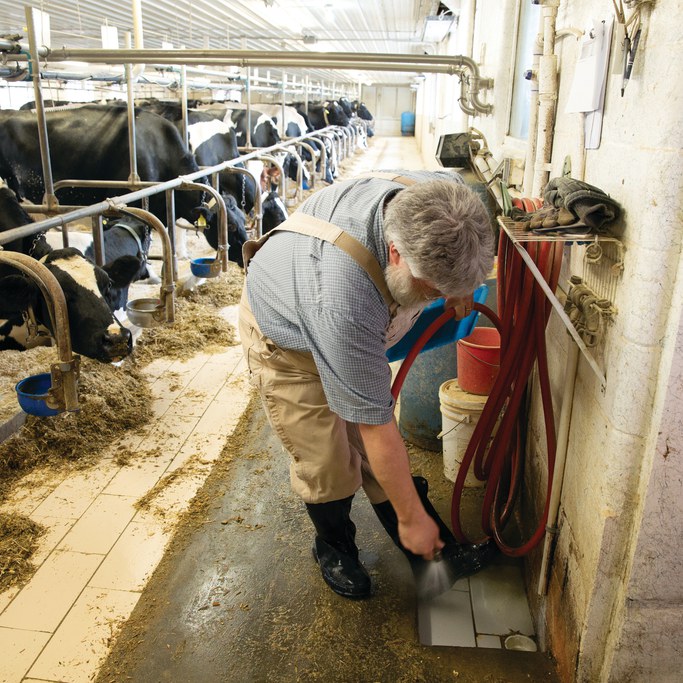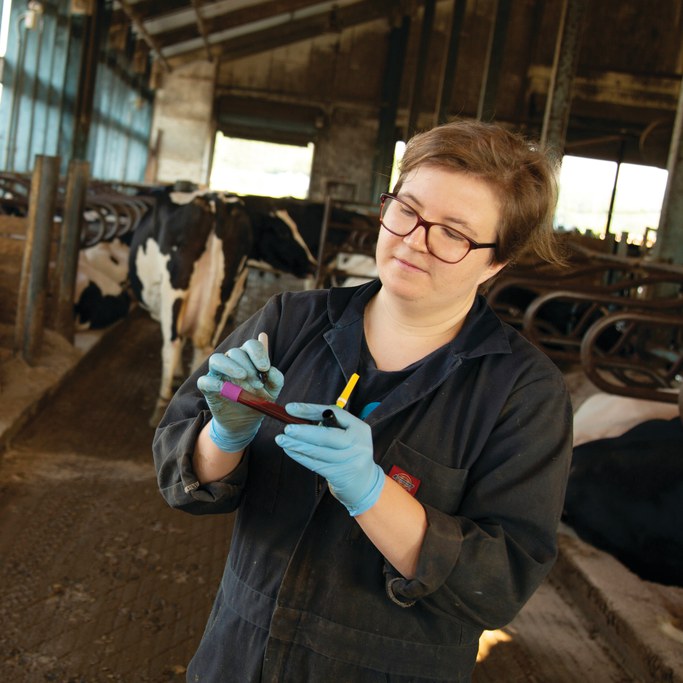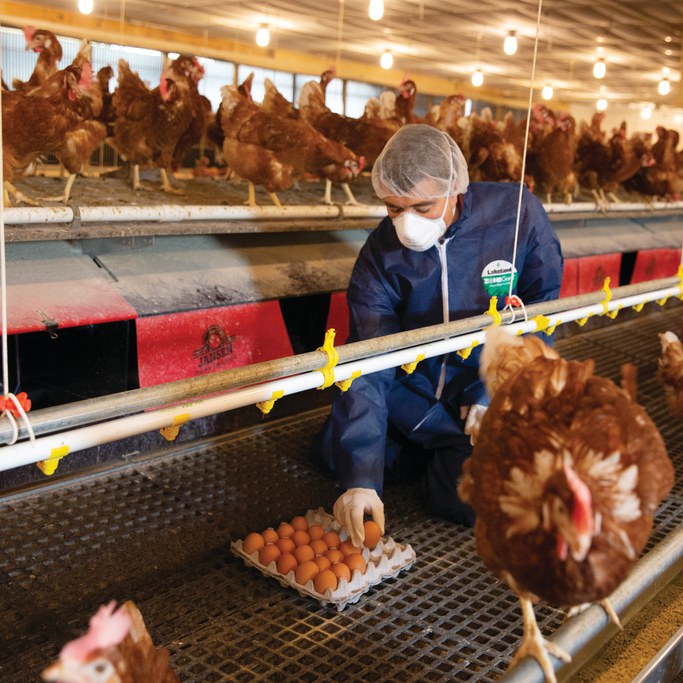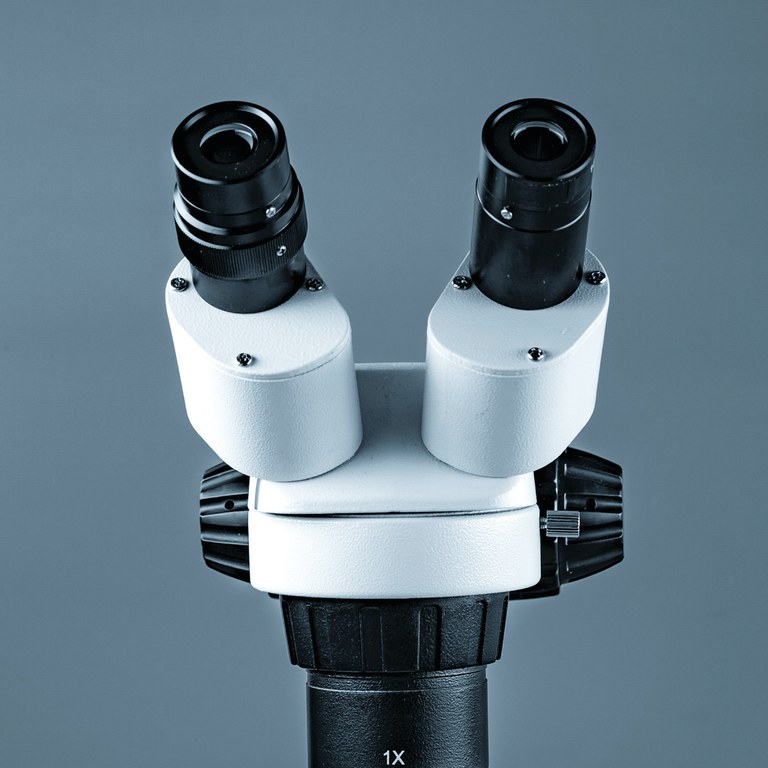Posted: March 2, 2020
Researchers in the college analyze tens of thousands of animal samples a year, searching for pathogens that have the potential to cause deadly pandemics and billions of dollars in losses.
The case was submitted by the Pennsylvania Game Commission. Three wild turkeys were acting strangely, stumbling around a backyard in suburban Erie. A wildlife officer captured one of them, and soon the bird--by now deceased--arrived in the lab of Eva Wallner-Pendleton.
At about the same time last fall, Wallner-Pendleton received reports of sick birds at a pheasant operation on the other side of the state, in Monroe County. Before their death, they appeared to have neurological issues, and a few of those fowl also made their way to Wallner-Pendleton.
As a clinical associate professor and avian pathologist at Penn State's Animal Diagnostic Laboratory, Wallner-Pendleton performed necropsies on the birds, the brains of which showed microscopic evidence of encephalitis. Because encephalitis has several potential causes, samples underwent further examination using a polymerase chain reaction (PCR) test, a tool that allows specific and rapid diagnosis of infectious diseases caused by viruses and bacteria. Meanwhile, the Pennsylvania Department of Agriculture was also investigating separate suspected cases of encephalitis in horses in Carbon, Luzerne, and Mercer Counties.
In all of these cases, the PCR testing came back positive for eastern equine encephalitis, often referred to as EEE, a serious mosquitoborne viral disease that is known to strike, as its name implies, horses. However, the pathogen also can affect upland game birds, wild turkeys, and, rarely, people. Only about 4-5 percent of people who get the virus develop encephalitis, but of those who do, roughly 30 percent will die, and survivors may suffer permanent neurological problems.
An average of about seven human cases of EEE occur annually in the United States, but as of mid-December, the U.S. Centers for Disease Control and Prevention reported 38 confirmed cases in 2019, mostly in the Northeast, Mid-Atlantic, and Michigan, including 15 deaths. Although no human cases were reported in Pennsylvania, the quick diagnosis of the virus in animals in different regions of the state enabled agriculture officials and Penn State Extension to issue timely warnings to residents--and in particular horse owners--to protect their animals and themselves from mosquitoes to reduce the risk of contracting the disease.
This sudden spike in EEE cases--referred to as the worst such outbreak since federal health officials began tracking EEE about 15 years ago--spotlights the important role of the College of Agricultural Sciences, the college's Animal Diagnostic Lab, and Penn State Extension in disease surveillance, diagnosis, preparedness, and response. The college's scientific expertise, research infrastructure, and educational networks combine to help create a powerful bulwark that protects and promotes animal and human health, as well as the economic success and sustainability of Pennsylvania's animal agriculture industries.
The Animal Diagnostic Lab is a keystone in that effort. The lab is part of the state-funded Pennsylvania Animal Diagnostic Laboratory System--PADLS for short--which also includes the Pennsylvania Veterinary Laboratory at the Department of Agriculture in Harrisburg and the University of Pennsylvania's New Bolton Center in Kennett Square. Together, the three labs each year perform more than a half million tests for all animal diseases. What sets the college's lab apart is its connection to Penn State's land-grant research, extension, and educational enterprises.
The $1.7 billion poultry industry, Pennsylvania's second-largest agricultural sector after dairy, relies heavily on PADLS for surveillance and diagnostic services related to poultry diseases, such as avian influenza. The state has been on high alert for avian flu after a major 2014-2015 outbreak, mostly in the Midwest, led to the deaths of more than 50 million turkeys and laying hens in 21 states, with estimated economic impacts in the billions of dollars. The Keystone State was spared during that outbreak, but because avian flu viruses are carried by migrating waterfowl, the threat is ever present.
"We performed nearly 71,000 tests for avian flu in the past year," said Wallner-Pendleton, who works closely on diagnostics and field investigation with colleague Patricia Dunn, a fellow avian pathologist at the Penn State lab. "We've recently seen about a 30 percent increase in submissions from sources such as the Game Commission, veterinarians, and owners of both commercial and small pet flocks. Also, with small 'backyard' flocks rising in popularity, we're sometimes seeing diseases that we haven't seen in years. Because these birds typically are outdoors, they're encountering things that up until a few years ago were fairly rare."
A Rare Disease
One such disease is avian coryza, a bacterial respiratory infection caused by Avibacterium paragallinarum. Infected chickens display symptoms similar to a severe head cold: facial swelling, discharge from the nose and eyes, sneezing, and coughing. Feed intake is decreased, slowing broilers' growth rate and delaying their market age, and layers will show a sharp drop in egg production--as much as 40 percent. The illness is typically not fatal, but producers must absorb the costs of lost production and needed veterinary care, such as antibiotics and vaccination.
"We've seen more than 60 cases of coryza across Pennsylvania since early 2019," Wallner-Pendleton said. "That's very unusual. This is an illness that typically is more of a problem on the West Coast and in the southern United States, and only occasionally in the Northeast. An outbreak like this is unprecedented, and we still don't completely understand how it's spreading all over the state."
Microbiologist Suresh Kuchipudi is among college researchers studying these coryza outbreaks. A clinical professor of veterinary and biomedical sciences and assistant director of the Animal Diagnostic Lab, he led an effort to develop a real-time PCR test for coryza to speed diagnosis and get a handle on how the pathogen is spreading.
"Until recently, the only labs that had a confirmatory test for coryza were in Georgia and California," Kuchipudi said. "We were sending samples to Georgia, which added costs for shipping, and we had to wait four to six weeks for results. At the same time, there was significant concern from the poultry industry, which needed answers to respond to this emergency."
Kuchipudi first worked with other labs and college experts in genomics and bioinformatics to sequence the genome of the coryza pathogen in a matter of a few months. Using this sequencing, his team developed an assay for coryza, which was validated and received fast-track approval from the Pennsylvania Animal Health and Diagnostic Commission.
"The outbreak started in late December of 2018, and by June we could offer this test, which is the first probe-based PCR assay for this disease in the world," he said. "Now, many states are sending samples to us, and we earned the trust of the poultry industry, which knows when they face a crisis, Penn State has the capability to step in and help find solutions."
The availability of the new rapid test, Wallner-Pendleton noted, means that clients sending suspected cases of coryza to the Penn State lab now can expect to receive results within two days. "It's really wonderful that we have this tool now," she said.
Biosecurity on Farms
With information from the coryza genome sequencing in hand, scientists determined that the same pathogen--rather than unique strains--has been involved in cases around the state, indicating that farm-to-farm transfer is likely the primary avenue of infection. And that illustrates the critical need for sound biosecurity on farms, which researchers and extension specialists say is the single most effective method for keeping flocks and herds healthy.
The importance of biosecurity in safeguarding the health of food animals becomes apparent when you consider the economic contributions of animal agriculture in Pennsylvania, contends David Swartz, Penn State Extension assistant director for animal systems programs. He highlights the fact that nearly 70 percent of Pennsylvania's agricultural receipts come from animal ag, and with razor-thin margins, producers who lose production to disease--even if not fatal to animals--may have their profits wiped out.

Biosecurity procedures, such as vaccinating animals and routinely monitoring their health, are of utmost importance in preventing the spread of disease. Through research dissemination, laboratory services, and extension courses, faculty and staff in the college support farmers to reduce their risks.
"When we ask the swine and poultry industries what their top priorities are for partnering with extension to address, the first one is animal health, including biosecurity and disease monitoring and prevention," said Swartz. "When the Animal Diagnostic Lab and the other PADLS labs diagnose or discover significant information about disease, we disseminate that to producers. Education on biosecurity and disease detection is part of almost every livestock and poultry program we offer."
That includes 4-H, Swartz said. "The co-mingling of show animals at a place like the Pennsylvania Farm Show or a large county fair is an incredible risk for disease transmission. We push biosecurity information out to every 4-H member who does an animal science project, and we educate them about the signs of disease to look for in their animals. That's a very important part of their 4-H education."
Swartz points out that biosecurity is a challenge for many producers. "These operations depend on so many partners, such as service people who are bringing feed, supplies, and new animals onto the farm," he said. "And that means they're dependent on those service and delivery partners to follow biosecurity protocols and maintain vigilance as well. Producers also need to instill biosecurity awareness in their workforce--they really depend on their farm managers and workers to do the right thing every single day with no let up."
The geography of the state's animal agriculture also presents biosecurity challenges. "Animal ag is very densely located, largely in the southeastern and southcentral regions of the state, making it easier for diseases to spread from farm to farm," Swartz said. "In addition, the majority of our animal agriculture is co-located with the biggest portion of the human population of the state, so there are many nonfarm vectors for disease transmission. Likewise, the presence of major transportation corridors like railroads and interstate highways in our intensive agriculture areas provides more opportunity for pathogens to spread."
Disease from Abroad
Elizabeth Hines says animal health and biosecurity long have been high priorities for pig producers, but they are especially "top of mind" with the current threat of African swine fever looming over swine herds around the world. The assistant professor of animal science serves on a state-led African swine fever task force, which is planning for how the state would respond should this devastating disease come to American shores.
So far, African swine fever, which is not a threat to people, has killed or led to the culling of hundreds of millions of swine in Asia and Europe, amounting to roughly a quarter of the world's domestic pigs. The viral disease has roiled global pork markets and caused shortages in many countries. Hines said the task force has concentrated heavily on what protocols and procedures will be triggered in a potential Pennsylvania outbreak. But protecting the state's pigs starts with biosecurity, which Hines promotes as she works with producers on production and management issues in her role as an extension swine specialist.
"For swine farmers and other livestock producers, it's really about controlling, to the best of their ability, what interacts with their animals," Hines said. "It's about putting hurdles in front of pathogens or anything else that may threaten animal health. You don't want to allow people onto your premises who may carry an animal disease from another farm. Washing or disinfecting of shoes and vehicles and buying feed from a reputable feed mill that has quality control are great first steps to protecting the health of your herd from outside threats. Make sure animals are vaccinated and that sick animals are treated promptly and properly to prevent and minimize disease spread within your herd.
"Biosecurity protocols may seem inconvenient, but taking a couple extra steps to protect your herd can be one of the best investments you make."
Last fall, PA Pork's Strategic Investment Program funded eight workshops in which Hines walked producers through the Secure Pork Supply initiative, which focuses on building an advanced biosecurity plan. Supported by the USDA Animal and Plant Health Inspection Service and the pork industry, and developed by the Universities of Iowa and Minnesota, the Secure Pork Supply initiative is a voluntary program that helps producers to protect their herds and stay in business in the event of an infectious disease outbreak, during which government regulatory agencies would limit the movement of animals and animal products to control disease spread. "For many producers in Pennsylvania who participated in the workshops, this was the first time they had a written biosecurity plan," she said.
Hines is also working with Kuchipudi to expand linkages between the Animal Diagnostic Lab and Penn State Extension related to diseases affecting pigs, and the two are developing a swine health short course that Hines hopes to offer to producers for the first time in spring 2020.
The Penn State Extension Poultry Team is involved in similar efforts, Swartz said. Members of the team serve on a state avian flu task force and hold a poultry health meeting eight times per year in Lancaster to update industry leaders on new research and disease information.
As a result, if an outbreak of African swine fever, avian flu, or other major disease occurs, Penn State Extension is well positioned to support government agencies in the response. While the Pennsylvania Department of Agriculture and USDA may impose quarantines and restrict the movement of animals, extension specialists and county-based educators will provide expertise and local knowledge.
"Educators may have knowledge of a specific swine operation and may be called upon to consult," Hines said. "They can advise on how a farm is set up or the age of the animals at the site, which can influence the exact response plan. We also have educators that are trained on methods for depopulating a herd or flock and composting or otherwise disposing of a potentially large number of carcasses, if that would become necessary."
A key asset that Penn State Extension brings to its partnerships with government agencies and the animal ag industry is its statewide presence, according to Swartz.
"We have people across the state, and we are requiring all our educators to learn about animal diseases, even for species outside their regular program areas," he said. "I want our dairy educators to have a working knowledge of African swine fever. I want our equine educators to have a working knowledge of avian flu. Even if they are not working with producers of these species on a daily basis, I want all the people in our system who have animal science responsibilities to have cross-training and baseline knowledge so they're able to more quickly respond to what's in front of them."
Forward Thinking
Of course, looking toward the horizon and anticipating potential diseases before they become threats is preferable to responding to an outbreak. Faculty in veterinary and biomedical sciences and the Animal Diagnostic Lab conduct research aimed at proactively investigating the potential for new diseases and studying existing pathogens to prevent them from escalating in new ways. Bhushan Jayarao, Animal Diagnostic Lab director and professor of veterinary and biomedical sciences, cited Salmonella in dairy herds as one example.

With help from farmers across the Commonwealth, the Animal Diagnostic Lab is prepared to respond quickly to disease threats.
"The dairy industry has been vaccinating for the last 30 years to prevent salmonellosis in dairy cattle," Jayarao said. "Yet, the incidence of salmonellosis has not declined. Plus, we are seeing other serotypes of Salmonella that we typically hadn't seen in dairy cattle."
Researchers hypothesized that the vaccine may be losing its efficacy. To investigate this phenomenon, scientists at the lab are sequencing the genomes of nearly 500 Salmonella isolates in the lab's collection to determine if they have evolved over time to become more pathogenic and able to survive in the face of antibiotics and vaccines.
"We want to determine whether, after 30 years, the vaccine pressure is resulting in more virulent types of Salmonella--in other words, driving the evolution of vaccine-resistant strains," Jayarao said. "If so, maybe we should change the strains we use to make the vaccines so we can address this emergence of resistance. In a few years, our results from this study could impact the treatment of salmonellosis in dairy cattle but also could be applied to swine and poultry."
In another forward-looking study, Kuchipudi is exploring the potential for Zika virus to infect poultry, which could have serious implications for human health. A mosquitoborne virus that occurs mostly in tropical and subtropical regions, Zika has been associated with severe symptoms, including microcephaly in infants infected in the womb and Guillain-Barré syndrome in adults.
"Zika belongs to the same family of viruses as West Nile virus, which can infect wild birds and poultry," Kuchipudi explained. "So a key question becomes, can Zika also infect poultry? If it does, we may or may not have a poultry production problem on our hands, but then we'd also have poultry flocks acting as massive factories making this virus, which threatens people as well."
This intersection of animal and human health is a growing focus in the research community and in the college. Many animal diseases are zoonotic, meaning they can jump species to infect humans as well. According to the Centers for Disease Control, six out of every 10 infectious diseases in humans are spread from animals. Among prime examples are rabies and various subtypes of avian and swine flu. This convergence is at the center of the One Health concept, a holistic approach recognizing that the health of people is connected to the health of animals and the environment.
In this vein, faculty in veterinary and biomedical sciences, the Animal Diagnostic Lab, and other departments in the college have developed a One Health undergraduate minor, which launched this spring. Jayarao, who coordinates the minor, calls it a valuable academic credential that can broaden students' perspectives and strengthen the record of those who apply to veterinary or medical schools.
"Traditionally, we tend to look at health through the different silos of human health, animal health, and environmental health," he said. "In reality, they all are interrelated. For example, if an animal carries a disease, and weather conditions cause the animal to change its behavior so it comes into contact with humans or pets, it may pass along that pathogen. If climate change results in disease-carrying mosquitoes expanding their range, they may transmit viruses to humans and animals that weren't previously exposed. You can't ensure animal and human health without addressing the health of the environment."
Added Kuchipudi, "We have a lot of knowledge in the animal world that medical doctors may not be aware of. Similarly, environmental scientists and toxicologists have information that we might not have. So One Health is bringing people from different fields of expertise into one platform to safeguard people, animals, and the world we live in."
Teaming Up for Prevention

Animal infectious diseases such as avian influenza and African swine fever pose significant global threats to animal health, economic stability, and food security. The need to explore the emergence, spread, and control of these diseases led the College of Agricultural Sciences, the Pennsylvania Department of Agriculture, and Penn State's Center for Security Research and Education to plan the inaugural Emerging Animal Infectious Disease Conference, which which will take place on March 23-25 in State College.
The conference will bring together veterinarians, farm owners, extension educators, state and federal regulators, researchers, and industry representatives from around the world to discuss successes and lessons learned from past foreign animal disease outbreaks. Other goals include prioritizing research, preparedness, and response strategies aimed at safeguarding human and animal health, according to Rick Roush, dean of the College of Agricultural Sciences.
"Our national security depends on investments in protecting our animal agriculture from infectious diseases from across our borders," said Roush. "African swine fever is a particular threat. Penn State is well positioned to lead cutting-edge research in the detection, diagnosis, and prevention of these diseases. We are pleased to be a driving force behind this conference."
Organizers hope the event will provide opportunities to learn from, and compare notes with, internationally renowned experts on high-consequence diseases affecting major agricultural species--African swine fever in pigs, avian influenza and Newcastle disease in poultry, and foot-and-mouth disease in cattle--noted conference co-chair Suresh Kuchipudi, clinical professor of veterinary and biomedical sciences.
"One thing we hope attendees take away is the critical need for biosecurity," he said. "Because there's no vaccination for African swine fever, for example, the best thing you can do to prevent losses and ensure sustainability is to improve your biosecurity."
Kuchipudi said information gleaned from the conference may also help inform the development of a planned biosecurity certificate training course that Penn State will offer in the near future.
Features
Fostering Forests
Across the United States, forests face unprecedented threats, and scientists in Penn State's College of Agricultural Sciences are conducting novel and complex research to conserve them.
Buzzing With Purpose
Community scientists work to protect Pennsylvania's wild bees
Conservation Reimagined
Exploring new approaches to cope with a changing climate



